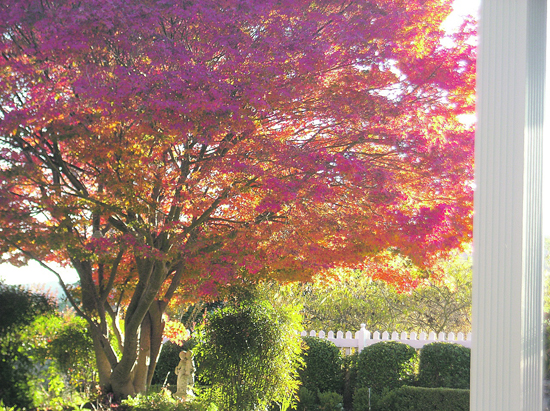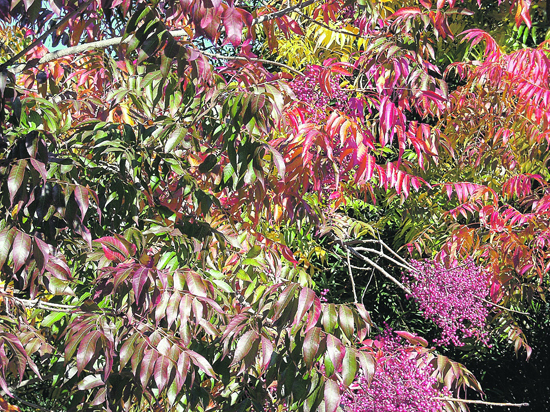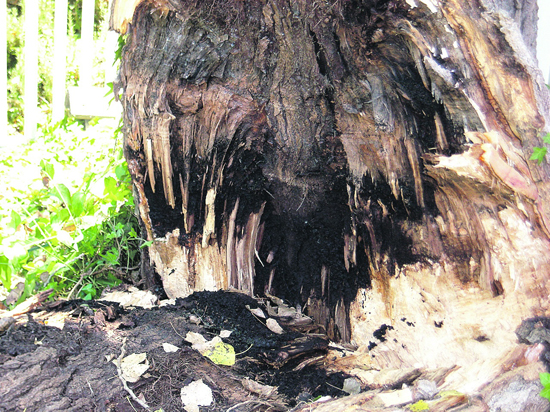| | Published September 29th, 2010
| Gardening with Cynthia Brian: FALL-ING
| |  | | Japanese Maple is awe-inspiring Photos Cynthia Brian
|
We arrived home from Lake Tahoe and couldn't get into our driveway. Half of our magnificent cottonwood tree blocked the road. About sixty feet of branches sprawled across the front yard. A herd of deer, including two bucks, nibbled on the leaves, while ten wild turkeys double-gobbled. Amazingly, it was a clean fall and nothing was broken-not the sprinklers, statuary, or other plantings. We were grateful we had not been home as this is an area where I am always gardening.
 My grandfather was not so fortunate. Two gigantic American elms graced his Napa Valley landscape, both infected with Dutch Elm disease. After my uncle's new truck was crushed by a falling limb, my grandpa petitioned the city of Napa for the right to have the trees removed. He was told the trees were protected and endangered. He was not allowed to have them cut down. One clear still day as he was mowing his lawn, the giant elm decided to topple, killing him instantly.
My grandfather was not so fortunate. Two gigantic American elms graced his Napa Valley landscape, both infected with Dutch Elm disease. After my uncle's new truck was crushed by a falling limb, my grandpa petitioned the city of Napa for the right to have the trees removed. He was told the trees were protected and endangered. He was not allowed to have them cut down. One clear still day as he was mowing his lawn, the giant elm decided to topple, killing him instantly.
 How healthy are the trees on your property? At this time of year, it's important to prepare for Indian summer heat as well upcoming winter storms. Inspect your trees for disease, dead branches, or split trunks. Get out the chain saw to remedy the situation and stake or anchor trees that could be uprooted or broken by wind. There are arborists in our community who know exactly how to prune, cut, or eliminate aesthetically. Check your local Chamber of Commerce for names of members you can rely on.
How healthy are the trees on your property? At this time of year, it's important to prepare for Indian summer heat as well upcoming winter storms. Inspect your trees for disease, dead branches, or split trunks. Get out the chain saw to remedy the situation and stake or anchor trees that could be uprooted or broken by wind. There are arborists in our community who know exactly how to prune, cut, or eliminate aesthetically. Check your local Chamber of Commerce for names of members you can rely on.
 Trees fall in storms and trees fall on completely calm, tranquil days. The factors contributing to a falling tree are the character of the wood, moisture in the soil, depth of the roots, accumulation of dampness on the leaves and branches, and ferocity of the wind. Fast-growing trees normally have shallower roots while pines, cedars, and evergreens such as magnolia risk damage because of expansive branching. When the soil is drenched, any tree is susceptible to breakage. Safety of human life as well as the longevity of the specimen rely on arduous attention.
Trees fall in storms and trees fall on completely calm, tranquil days. The factors contributing to a falling tree are the character of the wood, moisture in the soil, depth of the roots, accumulation of dampness on the leaves and branches, and ferocity of the wind. Fast-growing trees normally have shallower roots while pines, cedars, and evergreens such as magnolia risk damage because of expansive branching. When the soil is drenched, any tree is susceptible to breakage. Safety of human life as well as the longevity of the specimen rely on arduous attention.
 Fall is also the time to enjoy the kaleidoscope of colors in nature's trees. The deep reds we witness are a result of an increase in the sugar content while the yellows are a diminishment of chlorophyll due to the sunny days of autumn combined with the cooler evening temperatures. Although the chilly nights do deserve some credit for the rapid foliage change, the true reason that the leaves change color is dependent on species and environment. Japanese maples, dogwoods, liquid ambers, and some species of crepe myrtle appear flaming while redbud, ginkgo, birch, apple, and larch shimmer in yellows and gold. Oaks change to russet, Chinese pistache herald Halloween with their pumpkin orange hues. If you wander the creeks or hillsides, beware of poison oak as it is one of the most gloriously colored vines of autumn melding crimson, sienna, and scarlet. As the days grow shorter and the nights linger longer, the biochemical process paints nature's landscape with a sunset palette.
Fall is also the time to enjoy the kaleidoscope of colors in nature's trees. The deep reds we witness are a result of an increase in the sugar content while the yellows are a diminishment of chlorophyll due to the sunny days of autumn combined with the cooler evening temperatures. Although the chilly nights do deserve some credit for the rapid foliage change, the true reason that the leaves change color is dependent on species and environment. Japanese maples, dogwoods, liquid ambers, and some species of crepe myrtle appear flaming while redbud, ginkgo, birch, apple, and larch shimmer in yellows and gold. Oaks change to russet, Chinese pistache herald Halloween with their pumpkin orange hues. If you wander the creeks or hillsides, beware of poison oak as it is one of the most gloriously colored vines of autumn melding crimson, sienna, and scarlet. As the days grow shorter and the nights linger longer, the biochemical process paints nature's landscape with a sunset palette.
 October is the perfect time to buy shrubs, trees, and bushes because the soil is still warm, yet there is moisture in the air to assist with rooting. In addition, nurseries often offer discounts as they clean out inventory before the winter season. To find the colors your want in your garden, what better opportunity than to see them in their magnificent autumn cloaked splendor? Plan for future energy savings by planting a windbreak of low-crown shrubs which can cut your heating bills by thirty percent. Keep in mind that the distance from your home foundation needs to be two-five times the mature height and that smaller bushes planted within one-three feet will act as insulation.
October is the perfect time to buy shrubs, trees, and bushes because the soil is still warm, yet there is moisture in the air to assist with rooting. In addition, nurseries often offer discounts as they clean out inventory before the winter season. To find the colors your want in your garden, what better opportunity than to see them in their magnificent autumn cloaked splendor? Plan for future energy savings by planting a windbreak of low-crown shrubs which can cut your heating bills by thirty percent. Keep in mind that the distance from your home foundation needs to be two-five times the mature height and that smaller bushes planted within one-three feet will act as insulation.
 Gather the falling leaves for your compost pile. The decomposition replenishes the nutrients in your soil. Dispose of diseased or bug infested leaves, such as those that have peach leaf curl, rust, or aphids.
Gather the falling leaves for your compost pile. The decomposition replenishes the nutrients in your soil. Dispose of diseased or bug infested leaves, such as those that have peach leaf curl, rust, or aphids.
 As the growing season comes to an end, collect the seedpods from companion flowers to attract beneficial insects for next year's plantings including dill, caraway, anise, alyssum, marigolds, calendulas, sunflowers, zinnias, hollyhock, and nasturtium. Dry them on cookie sheets or in plain brown paper bags providing plenty of air circulation. Store in paper bags, labeling with name and date. You'll be ready to plant the seeds next spring, and of course, be cautious with the use of pesticides. The goal is to attract beneficial insects, bees, butterflies, and hummingbirds and keep them alive and healthy.
As the growing season comes to an end, collect the seedpods from companion flowers to attract beneficial insects for next year's plantings including dill, caraway, anise, alyssum, marigolds, calendulas, sunflowers, zinnias, hollyhock, and nasturtium. Dry them on cookie sheets or in plain brown paper bags providing plenty of air circulation. Store in paper bags, labeling with name and date. You'll be ready to plant the seeds next spring, and of course, be cautious with the use of pesticides. The goal is to attract beneficial insects, bees, butterflies, and hummingbirds and keep them alive and healthy.
 It's also time to plant your winter crops, specifically peas, spinach, lettuce, chard, parsley, and chives, which won't require much sunlight. It's also a great idea to plant a cover crop of beans, peas, or vetch to add nitrogen to your dormant vegetable garden. Your soil will be restocked with the nutrients that were depleted from this season's crops.
It's also time to plant your winter crops, specifically peas, spinach, lettuce, chard, parsley, and chives, which won't require much sunlight. It's also a great idea to plant a cover crop of beans, peas, or vetch to add nitrogen to your dormant vegetable garden. Your soil will be restocked with the nutrients that were depleted from this season's crops.
 In your flower garden, dig up extra gladiola cormlets. Nick them gently or soak them in full strength bleach for a few hours which will help them sprout when planted. Place in full sun, dug into the ground about two inches deep. Divide your bearded iris rhizomes and re-plant where you need more color. Wait until November to plant daffodils, crocus, and tulips.
In your flower garden, dig up extra gladiola cormlets. Nick them gently or soak them in full strength bleach for a few hours which will help them sprout when planted. Place in full sun, dug into the ground about two inches deep. Divide your bearded iris rhizomes and re-plant where you need more color. Wait until November to plant daffodils, crocus, and tulips.
 Fall is in full swing. Enjoy the colorful show from your hammock. Make certain the branches are healthy and strong while you watch Fall falling.
Fall is in full swing. Enjoy the colorful show from your hammock. Make certain the branches are healthy and strong while you watch Fall falling.

|
 | | Chinese Pistache puts on a show
|  | | Cottonwood trunk split and the tree fell
|  | | Bird feeder amidst fall brushstrokes
Photo Cynthia Brian
|
Cynthia's Digging Deep Gardening Guide for October
The ancient Celtic, Christian, and Roman ritual mixed with European folklore marks our Halloween holiday, a day when the dead walk the earth again. Goblins, ghosts, and modern Druids commemorate with costumes, parades, and commercial festivities. Every year I dress up for the trick-or-treaters. Besides the typical witch, cheerleader, princess, and Dracula, I've been a firefighter, pirate, terrorist, superwoman, and Cynthiarella. This year, I am a horticulurist. Don't be too scared...I'll be digging deep!
Here's what needs to be done in your graveyard, oops, I mean garden in October.
- PRUNE your berry vines after you have harvested the fruit for easier picking next season.
- ORDER your spring bulbs from catalogs now for planting in November
- PICK any fruit that has fallen to the ground to prevent insect attraction or disease.
- DEADHEAD spent annuals.
- MOVE baskets and pots to a shady area when Indian summer is hottest.
- THROW two or three matchsticks into each hold before planting bulbs. The sulphur kills
insects and enriches the soil.
- PROPAGATE geraniums and pelagoniums by cutting back nonblooming stems
and planting in damp soil.
- BUY trees boasting autumn colors now.
- STAKE young trees and prune dead or dried limbs from established ones.
- CALL an arborist to inspect your large limbs and trunks.
- VISIT nurseries to check out the fall selection of plants and bulbs.
- CHECK around your house for fire hazards and flammable materials.
October is the height of fire season.
- FERTILIZE begonias and roses for more blooms.
- FEED your citrus.
- TRANSPLANT calendulas, Iceland poppies, dianthus, forget-me-nots, primroses,
Shasta daisies, agapanthus, and daylilies.
- FREEZE or can your extra harvest of fruit and vegetables for winter delights.
- EAT the flowers on your herbs, such as chives, garlic, basil, mint, dill, and other flowering herbs.
- HARVEST the last of your grapes. Add the colorful leaves and vines for a spectacular
autumn arrangement.
- RAKE your leaves into a compost pile. Great soil will be ready before the holidays.
- PLANT your new lawns or reseed tired ones
now for the fastest, healthiest growth.
- DECORATE your front porch with cornstalks
from your garden
- PICK your pumpkins and carve funny
jack o'lanterns.
Have a haunted Halloween!
Happy Gardening to You!
(c)2010 Cynthia Brian
|
 | | | | | | Advertisement | | |
| | | | | | Comments | | | | | |  | | |
| | |  | | |
| | | | |









